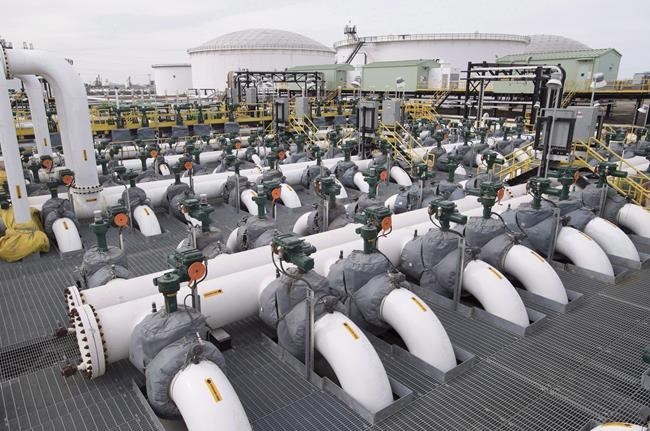
Pipes are seen at the Kinder Morgan Trans Mountain facility in Edmonton, Alta., Thursday, April 6, 2017. The potential cancellation of the Trans Mountain pipeline expansion is putting a spotlight on oilpatch innovations that might mitigate the need for export capacity as oilsands production rises. But even the technologies' most ardent supporters agree Canada is going to need new pipeline space anyway. THE CANADIAN PRESS/Jonathan Hayward
Republished April 10, 2018 - 1:58 PM
Original Publication Date April 10, 2018 - 11:56 AM
CALGARY - The potential cancellation of the Trans Mountain pipeline expansion is putting a spotlight on oilpatch innovations that might mitigate the need for export capacity as oilsands production rises.
But even the most ardent supporters of the new technologies agree Canada is still going to need new pipeline space.
"What I think we should be doing is using the existing pipeline space we have to ship as much money out of Alberta as we can," said Ian MacGregor, president of North West Refining, operator of the just-opened Strathcona Refinery northeast of Edmonton.
"We should be making the most economically dense things we can."
He said the $9.6-billion refinery, the first new refinery in Alberta in 30 years and the first in the world to be built from scratch with a carbon capture component, is processing upgraded synthetic crude now but should move to processing raw bitumen in the next two months.
When fully operational, the refinery will take in about 80,000 barrels per day of diluted bitumen, extract about 30,000 bpd of diluent for return to the local market, then convert the remaining bitumen into 40,000 bpd of diesel, about 7,000 bpd of low sulphur marine fuel and about 4,000 bpd of naphtha, a liquid hydrocarbon mixture.
MacGregor said the lack of pipeline space in Western Canada has driven down the price of bitumen, which improves refinery profit margins, and is a positive factor in eventually expanding it.
If the refinery is expanded, however, its diesel production would exceed local demand and would need to be exported by rail or pipeline to other markets. He said diesel sells for about $150 per barrel now, around four times the price of raw bitumen.
Meanwhile, research continues on partial upgrading technology that, like the Strathcona refinery, would reduce or eliminate the need for tying up export pipeline space with diluent. Such facilities would cost much less to build than the full upgraders employed at some oilsands mines.
"Partial upgrading ... can help diversify the economy and improve the value of Alberta's resources by providing a new product to new markets," said Davis Sheremata, spokesman for oilsands producer MEG Energy Corp.
But the technology isn't expected to provide much pipeline relief in the short term. MEG has been working on its HI-Q technology for over 15 years and has proposed — but not yet funded — a commercial demonstration project to process 3,000 bpd of bitumen.
The Alberta government announced in February it would provide up to $1 billion in loan guarantees and grants to attract two to five partial oil upgrading facilities. But that project won't begin until 2019 and it is expected to remain in place for up to eight years.
Another technology that might free up pipeline space transforms bitumen into small dry pellets that can then be moved by rail, road or ship with less risk of environmentally harmful spills.
Pilot projects have been proposed for at least two similar products, one developed at the University of Calgary by a company called Solideum Inc. and another by Canadian National Railway — but large-scale implementation is months or years away.
"I think we need to look at partial upgrading and rail and increased pipe capacity, all of it," said Tim McMillan, CEO of the Canadian Association of Petroleum Producers.
In a report published Monday, analysts at GMP FirstEnergy Capital said Alberta oilsands production has doubled from the start of the decade to nearly three million barrels per day and is projected to grow to 3.5 million bpd by 2022.
It says crude-by-rail demand will likely rise to between 300,000 and 400,000 bpd for the next couple of years until new pipeline capacity comes onstream. Canada exported 144,000 bpd by rail in January, according to the National Energy Board.
About 800,000 bpd of Canadian oilsands heavy crude is being refined on the U.S. Gulf Coast now as imports decline from Mexico and Venezuela, IHS Markit reported on Tuesday.
In a prediction that assumes all major proposed Canadian export pipelines are built, it says Canadian exports there could rise by 2020 to more than 1.2 million bpd, one-third of the region’s heavy oil refining capacity.
Follow @HealingSlowly on Twitter.
Companies in this story: (TSX:MEG)
News from © The Canadian Press, 2018